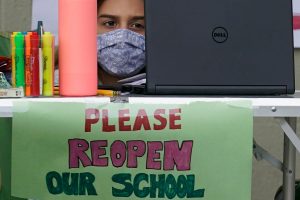As America’s schools reopen, here’s how to rebuild trust among parents, educators

Most Americans agree that reopening schools should be a question of science and student need, not politics. In practice, though, reopening has become yet another culture clash.
We need to get America’s kids back to school, expeditiously and effectively — and that’ll require practicality and trust, two things that have been in short supply of late.
The two of us have learned a lot about the importance of trust and practicality, as we spent the past year seeking to work across some of the polarizing divides so apparent in education today.
One of us is the dean of a major school of education and the other is a scholar at a major conservative think tank, so we start from very different perspectives. Yet, as we’ve listened to one another, we’ve found surprising instances of agreement. And we’ve found it easiest to discover common ground when we move from sweeping statements of principle to concrete questions of how to better serve kids.
This kind of focus on practicality and trust has much to offer as we seek to reopen schools and help students and communities thrive in the aftermath. For starters, the science makes it clear that most schools should be reopening now for in-person learning, and that nearly all schools should be in a position to offer five days a week of full-time, in-person instruction by June.
A student on Feb. 18, 2021, in San Francisco. (Photo: Jeff Chiu/AP)
However, turning that into a reality requires a key ingredient that’s missing in many communities: Trust.
Trust must be earned; it can’t be imposed. Not all families or staff feel comfortable returning in-person this spring. Mandates based on “the science” won’t make the distrust go away. Like it or not, different individuals and communities may view the same facts differently.
The communities hit hardest by COVID-19 are likely to be skeptical of the safety measures schools adopt, especially when their schools inhabit old, poorly ventilated buildings.
Families who had little choice about whether to keep their kids home for 12 months should have the choice to go back on a timeline they find comfortable. That will reassure nervous parents that they’re not being pushed around and avoid a backlash. This means that public schools have an obligation to provide a remote option to families who prefer it.
When it comes to staff, while many states have prioritized school staff for vaccination, the Centers for Disease Control has made it clear that teacher vaccination should not be a prerequisite for reopening schools. There’s a sensible compromise lurking here, one that’s gotten lost amid the union politics.
States should make every effort to prioritize K-12 staff for vaccines. Schools should ensure appropriate safety measures are in place and then make clear that staff are expected to return to work, with accommodations made for the most at-risk staff (generally by permitting them to handle remote instruction or support duties, when practicable).
Don’t rely on tests to evaluate teachers
As students return, educators need to know how they’re faring, what they need, and how much they have (or haven’t) learned in virtual classrooms. That suggests the value in administering assessments that are useful for instruction and student support.
At the same time, the exigencies of this school year argue against requiring states or schools to use these results to evaluate teachers or schools under state accountability systems.
More important than the specific assessments is how they’ll be used to provide students with the resources and support they need. Unprecedented federal relief funds are being delivered to schools, but decades of experience have taught us the harsh lesson that dollars must be spent wisely if they’re to make a difference. That calls for challenging, creative thinking, and not just propping up payrolls or adding supervisory staff.
School systems need to elevate their academic game while also providing students with essential social and psychological support.
Too many students were bored and alienated even before the pandemic. The pandemic’s massive disruption provides an opportunity to make schools better than they were.
Invest in tutoring to help kids catch up
If we are going to re-engage the millions of students who have fallen off the grid, we will need to figure out how to make education more compelling and engaging. Schools will need to devise extensive tutoring strategies — employing both digital resources and local recruits — and high quality summer learning opportunities to help students thrive.
None of this is easy. However, if we acknowledge the fears, the complexity of the challenges, and the fact we can disagree in good faith, education leaders and elected officials may find it easier to focus on establishing clear principles for a reopening that provides kids with the schools and support they need.
If we focus less on sweeping declarations and more on practical solutions, we may find that the particulars and the politics aren’t as intractable as they can seem.
Frederick M. Hess is director of education policy studies at the American Enterprise Institute. Pedro A. Noguera is dean of the Rossier School of Education at the University of Southern California. Their book, “A Search for Common Ground: Conversations About the Toughest Questions in K-12 Education,” was published recently.
You can read diverse opinions from our Board of Contributors and other writers on the Opinion front page, on Twitter @usatodayopinion and in our daily Opinion newsletter. To respond to a column, submit a comment to [email protected].
Source: Read Full Article

